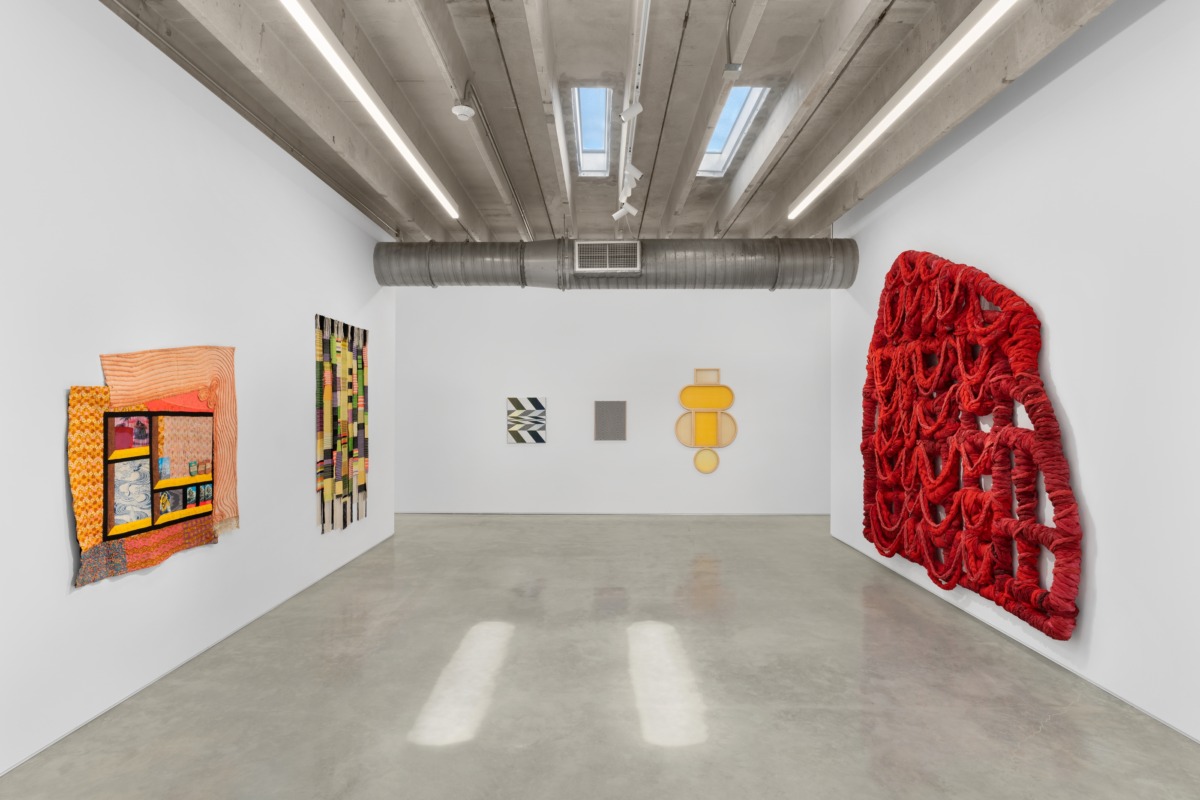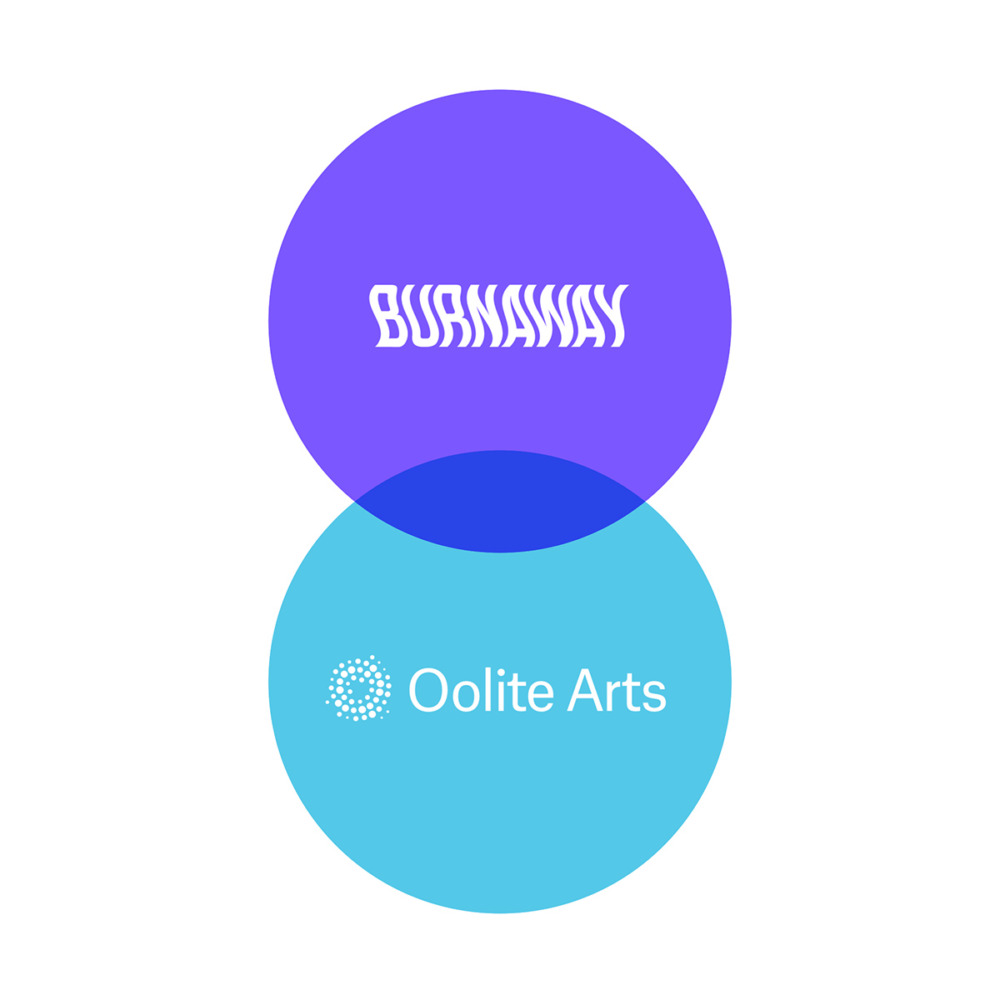
It is hard not to obsess over materiality at Hand Over Hand: Textiles Today, the latest group exhibition at the Mindy Solomon Gallery in Allapattah. The show, which features textile art from over 20 different artists, showcases the impressive range of contemporary fabric art as an agent for meaning and innovation. This narrative is presented through the pieces on display, finding cohesion in the variety of patterns, methodologies, and materials used in each, while employing physicality and inheritance to present unique approaches and bring us closer to new meanings. The result is exciting and necessary: it confronts the viewer with a different side to the familiar materials – the sculptural, the practical, the emotional – allowing us to experience the full scope of textiles.
Consider Elana Herzog’s breathtaking Forget Me Not, a blue chenille bedspread at the heart of the gallery. There is a fragility to this piece that feels counter-intuitive. The vintage chenille has been frayed and mixed with different textiles as if patched together to save its utility: there is an orange checkered backdrop throughout, while a yellow and deep red outline the borders and give the piece a composition that gravitates our eyes towards the pattern of flowers at the center. At every corner, this piece appears to be coming apart. So why am I so drawn to it? Forget Me Not, like many of Herzog’s other works, is evocative because of its focus not only on its making but its unmaking, allowing the artist to construct a language built on subtraction and ephemerality.
Working with second-hand materials is working with lived experiences. Objects like bedspreads, quilts, and clothing are functional and representational. They are symbols for moments and for people; they evoke memories through their stitching and their touch. Like Herzog, the artists Coulter Fussell and Basil Kincaid create their works with discarded and donated fabrics, allowing them to add another dimension to the already familiar medium of the quilt and explore narratives absorbed in humanity and interconnectivity.
In Fussell’s mixed-media Quilt Country Captain, we see windows displaying various scenes: a soldier, a warship and cigarettes covered with a veil, and images of water birds. Different fabrics surround them, including a mixed pattern fabric and a chenille bedspread. Fussell, a trained painter, approaches this piece with formal techniques like foreground and composition that help balance the focus between color, form, and the story the quilt tells. The heartbreaking Change is in the Air, Spring is on thy Lips by Kincaid approaches materiality in a similar way, incorporating donated clothes with those from a former lover to craft a playful, pastel-colored quilt. Like Fussell’s piece, Kincaid’s asks: how does the emotional significance to those who once enjoyed these materials shape our understanding of them?

Perhaps more immediate is the question of how the materials themselves shape our understanding of textile art because of their physicality. Through pieces like Family circa 1976 and Mrs. Hardway’s 4th Grade Kerry Phillips leverages the familiarity of the rug to evoke a unique feeling of nostalgia. These carpet portraits, based on family studio photographs, are made using found materials and carpet from the house the artist grew up in. Observing them feels like being back home all of a sudden: the layers are playful and bounce a familiar image anyone who has been part of a school photograph, or a family portrait will recognize. And in a sense, it is that memory, as Phillips, working in faceless subjects, presents something like a template rather than a particular memory, a recognizable pattern one can easily relate to, even if these scenes don’t fit with the particulars of a viewer’s memory. But the influence the carpet has on this feeling is undeniable: standing in front of these portraits is not like observing a canvas; there is a sense of a shared experience that happens because of the rug rather than despite it.
The felted wool in Melissa Joseph’s pieces, though generally smaller and more impressionist, are more entertaining in the specificity of their scope. There is a clear focus on movement in her pieces, exacerbated by the blurring surface of the wool. Like in Baby’s first Bharatanatyam, Joseph’s pieces feel like they are capturing a moment that is still ongoing. In conversation with Joseph, the writer Azikiwe Mohammed observed Joseph’s work emits a feeling as if the artist has already done the knowing for us. “There are many things I don’t know here, but I don’t feel the need to know. You shift that feeling into one of already knowing.” Indeed, observing a piece like Joseph’s Maps, wait, they don’t love you like I love you feels completely foreign, almost as if one were peering into someone else’s memories and experiencing them through their eyes, rather than our own. It entails focusing on what the artist focused on, as opposed to our individual inclinations, resulting in an outsider’s observation of the scene presented through the felted wool. It is this combination of form and material that gives Joseph’s work so much force.
The pieces on exhibition excel in their ability to remind us we’re not that far removed from them. Each begins with a sense of wholeness – from a memory, a feeling – and redefines it, removing and re-integrating fragments of narratives through the process. In Hand Over Hand, textiles take on a newly realized purpose, leaving us to contemplate the ways in which our perspectives are shaped by them.
Hand Over Hand: Textiles Today is on view at Mindy Solomon Gallery in Miami, FL from April 30th until June 3rd.

This piece was published in partnership with Oolite Arts as part of a project to increase critical arts coverage in Miami-Dade County.




